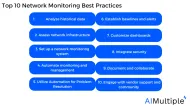Incident Management: Guideline for Incident Response in 2024
Incident management is an essential process in IT service management to ensure the continuity of the service and maintain customer satisfaction. Unsystematic incident resolution plans can be costly to the business and result in customer churn. This article will describe a guideline for incident management that can optimize your enterprise’s incident response speed and efficiency.
What is incident management?
Incident management is the response of DevOps and IT operations to a disruption or error in the service provided. The purpose of incident management is to minimize the negative effect of the disruption on the company by controlling the severity of the incident and finding quick solutions.
Incident management also includes post-incident review which helps companies learn and improve incident response. At this phase, IT teams analyze the core reason behind the incident and take measures to prevent future problems.
Read more: Data breach incident response.
What is an incident management workflow?
There are many approaches to the incident management process. ITSM (IT Service Management) is one of the most common approaches to incident management. According to ITSM, there are several stages of incident management.
- Incident detection and logging: Incident detection can take place through various sources. Some of the common methods of incident identification include user feedback, monitoring system detection, manual identification, and so on. Once the incident is detected, it must be logged in, covering the information about the problem, the time it was identified, the person who identified the problem and assign a tracking number for the case.
- Categorization: Categorization is an essential step for incident management. The correct categorization of incidents can show recurring trends in some categories. It helps find the root problems of the incidents, leading to better problem solving and reducing the number of incidents in the long run.
- Prioritization: There are two factors in prioritizing an incident:
- Impact: The IT team needs to estimate the potential impact of the interruption in the business service. This could have financial, security, or compliance implications. Moreover, the team should consider the number of customers affected by the incident to manage the customer experience.
- Urgency: Companies can define the urgency of an incident by analyzing a few time-sensitive matters. Does the impact of an incident keep growing? What is the priority status of the customers that are affected? Does preventing the incident hinder the development of other incidents? By answering such questions, IT teams can prioritize incidents based on their urgency.
4. Incident Response :
- Initial Diagnosis: The first agent, usually the help desk, analyzes the problem and tries to solve it without further assistance. They follow the procedure on scripts, diagnostic manuals, known error databases, and knowledge bases to resolve the problem.
- Escalation: If the first agent cannot solve the incident, it is forwarded to a team with technical expertise. The use of initial diagnosis decreases the workload of technical teams significantly.
- Investigation and resolution: In this phase, IT teams investigate the problem and find a solution for the incident. Sometimes they may also have to test the changes before the deployment.
- Closure: The service desk handles the incident closure. The service desk is also responsible for contacting the customer who reported the problem to check if the incident is completely fixed.
Why is incident management important?
A well-defined incident management process allows businesses to respond to incidents and maintain customer satisfaction quickly. Incident management minimizes the impact of the incident and creates guidelines for faster resolution of the problem in the future. This, in turn, allows IT professionals to redirect their focus more on the development rather than incident resolution.
Challenges
The main challenges and causes for problems in incident management are:
- According to a survey, almost half (44%) of the incident alerts are due to the changes made by a team member who does not have cross-departmental access to realize the impact of the change.
- One of the main concerns of the incident management teams is to track the process and record it under runbooks. Runbooks are detailed guides on how to solve a specific problem. Recording and creating runbooks ensures that the severity of future incidents is reduced. The guide described in the runbook can also be automated to eliminate the manual work for common categories of incidents.
- Information Accessibility: Many companies still rely on emails and spreadsheets to communicate the details of an incident with their teams. It is crucial to close this communication gap to speed up the resolution process.
Recommendations:
IT Service Management Tools work on all ITSM processes such as license management, asset management, ticketing and incident management. Enterprises can use ITSM tools to streamline the incident management process from identification and logging to closure.
Workload Automation tools can be used in the incident management process to control workflows across the teams effectively.
- Workload automation software ensures effective data communication between professionals and departments. This, in return, decreases the number of incidents that can arise from miscommunication.
- WLA tools track and document the incident resolution process allowing enterprises to access an audit trail and visit back in the future when an incident of the same category happens.
On the contrary to ITSM tools, IT professionals can use workload automation technology for any workflow across the enterprise.
If you believe your business can benefit from a workload automation solution or an incident response tool, check out our data-driven lists of workload automation software and incident response tools.
For guidance on how to choose the right solution:

Cem has been the principal analyst at AIMultiple since 2017. AIMultiple informs hundreds of thousands of businesses (as per similarWeb) including 60% of Fortune 500 every month.
Cem's work has been cited by leading global publications including Business Insider, Forbes, Washington Post, global firms like Deloitte, HPE, NGOs like World Economic Forum and supranational organizations like European Commission. You can see more reputable companies and media that referenced AIMultiple.
Throughout his career, Cem served as a tech consultant, tech buyer and tech entrepreneur. He advised businesses on their enterprise software, automation, cloud, AI / ML and other technology related decisions at McKinsey & Company and Altman Solon for more than a decade. He also published a McKinsey report on digitalization.
He led technology strategy and procurement of a telco while reporting to the CEO. He has also led commercial growth of deep tech company Hypatos that reached a 7 digit annual recurring revenue and a 9 digit valuation from 0 within 2 years. Cem's work in Hypatos was covered by leading technology publications like TechCrunch and Business Insider.
Cem regularly speaks at international technology conferences. He graduated from Bogazici University as a computer engineer and holds an MBA from Columbia Business School.
To stay up-to-date on B2B tech & accelerate your enterprise:
Follow on

Comments
Your email address will not be published. All fields are required.